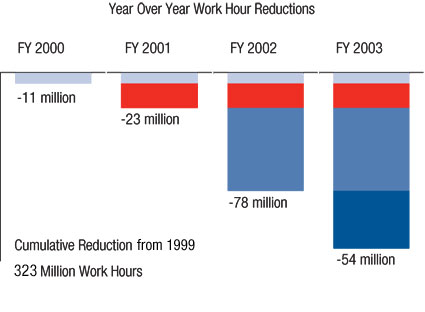management discussion & analysis
operations |
 Workers' Compensation
Workers' Compensation
Our employees are covered by the Federal
Employees' Compensation Act, administered
by the Department of Labor's Office of
Workers' Compensation Programs (OWCP)
which makes all decisions regarding injured
workers' eligibility for benefits. However, we
pay all workers' compensation claims out of
postal funds.
We record as a liability the present value of all future payments we expect to make to those employees receiving workers' compensation. At the end of 2003, we estimate our total liability for future workers' compensation costs at $7,114 million, an increase of $589 million or 9.0%. In 2003, we recorded $1,457 million in workers' compensation expense, compared to the $1,511 million we recorded in 2002. These amounts exclude Post Office Department workers' compensation costs, of $17 million in 2003 and $13 million in 2002.
In the past, workers' compensation
expenses tended to increase every year as
more and more employees received benefits.
With medical costs rising as they have in the
past several years, it remains imperative that
we reduce workplace injuries, manage current
claims and eliminate fraudulent claims.
 |
We expect costs related to workers'
compensation to remain stable in 2004 as a
result of initiatives that will help to minimize the
impact of rising medical costs. These initiatives
include actions to increase the rigor of medical
bill reviews, increase the recovery of expenses
related to injuries sustained by employees as a
result of their own actions and a joint initiative
with the Office of Workers' Compensation
Programs to increase the number of injured
employees returned to work.
In addition to the cost of workers' compensation
claims, OWCP charges us an
administrative fee for processing claims. In
2003, the administrative fee was $45 million
compared to $37 million in 2002 and $31
million in 2001.
(See Notes 2 and 3 of the Notes to
Financial Statements for additional details.)
Productivity
We use two indicators to measure our efficiency.
First, we use Output per Work Hour,
which measures the change in the relationship
between workload (mail volume and
deliveries) and the labor resources used to do
the work. Second, we use Total Factor
Productivity (TFP), which measures the
change in the relationship between outputs,
or workload and all the resources used in
producing these outputs. Our main outputs
are mail and special services and carrier
services to an expanding delivery network.
TFP calculations include inputs for all
resources including labor, materials, transportation
and capital investments.
During 2003, our Output per Work Hour
grew by 2.3% and our TFP improved by
1.8%. This TFP growth is equivalent to
$1,196 million in expense reductions. This
marks our fourth consecutive year of positive
TFP growth, with equivalent expense reductions
totaling over $4.4 billion over this time.
Our productivity growth continues to be driven
by substantial restraints on the resources we
use to produce our outputs. Again in 2003 we
were able to achieve positive TFP growth as
our workload declined for the third consecutive
|




